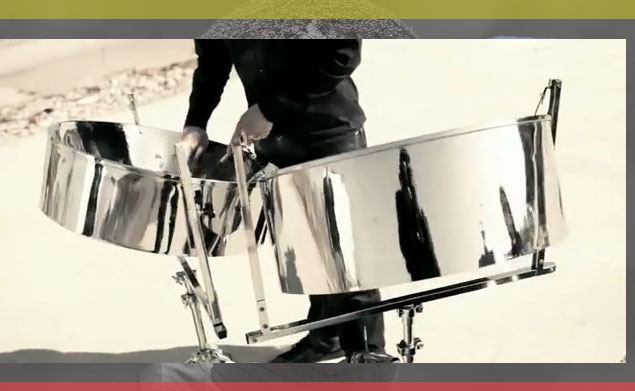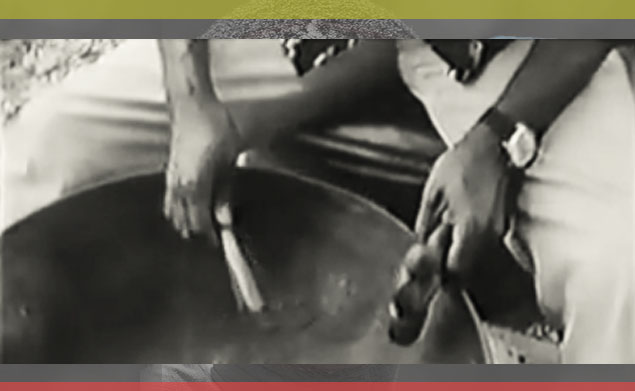Its commonplace on almost every Caribbean cruise; older men dressed in tropical shirts, hitting the sticks they hold in their hands against the corners of the shinny hollowed silver ‘bowls.’ To a large extent, these ‘bowls’ or steelpans have come to symbolize the Caribbean. Also referred to as ‘pans,’ steelpans orijinated in Trinidad and Tobago and is the national instrument of the Caribbean island. Pans also play an important role in almost all of the other Caribbean islands.
The history behind the creation of steelpans speaks volumes to the creativity and resourcefulness of the island’s inhabitants. Being African descendants, talking drums were a staple in the lives for Trinidadians in the 1800s. The special skin drums were used as a powerful communication tool, as various groups used them to communicate with each other across the island. Recognizing the power of this form of communication, the British Colonial government outlawed the hand drums in the 1880s, as they feared that the people will use this rhythmic form of communication to plot and revolt against their rule.
With the need of music and rhythm embedded in every fiber of their body, Trinidadians started to develop alternate means of generate music as they participated in the yearly Mardi Gras (today known as Carnival) festivities introduced to them by the French. In absence of the drums, Trinidadians developed the Tamboo-Bamboos, which were tunable sticks made of bamboo wood. the name of this new instrument also served as homage to the talking drums which were prohibited, as the word ‘Tamboo’ is derived from the French word tambeau or ‘drum.’ The Tamboo Bamboos were pounded against the ground and also against various abandoned metals and buckets to make various percussions and sounds. Like the talking drums, Tamboo-Bamboos were also outlawed by the ruling British colonial government, who insisted that this new instrument could be and was being used as tools by rival groups against each other.
With no talking drums or Tamboo-Bamboo, Trinidadians had to once again adapt to their environment and come up with other ways to maintain the rhythms and music they love. Since bits of metal percussions were being used in the Tamboo-Bamboo bands, and bamdoos were outlawed, the metal instruments began to dominate thebands. Some even recognized that when the pieces of bamboo struck the dented parts of the metal oil tins, they made an interesting sound and pitch. Through experimentation with the dents created in these oil tins or frums, it was discovered that the different dents generated different pitch and as a result, the steelpan was created.
In its inception, steelpans were traditionally made from 55 gallon drums that usually stored oil. Since many Trinidadians lacked the resources or funds to purchase or create traditional musical instruments such as pianos, guitars trumpets, ect., steelpans quickly became the instrument of choice for many poverty stricken youths. Given its roots and orijin and its mass appeal to the less affluent populations,there was an initial stigma attached to those who played this instrument (today steelpan players are known as pannists). However, with continued experimentation and the application of science, this stigma faded and the steelpan has become the instrument of choice throughout the Caribbean.
Today, steelpans are mostly made from sheet metal but they still maintain the bowl like shape they have always held. There are many types of steelpans, but the lead is called the ‘Tenor pan’, which has notes arranges in a circle of perfect fourth and fifth intervals. This fairly new percussion instrument keeps evolving and pannists and other artist are always developing ways to better tune and develop this percussion instrument. While the steelpan does have some limitations, such as its limited range, when compared to more established instruments, when the pair of straight sticks tipped with rubber hits against the pan, one cannot help by move to the rhythms it creates.
Steelpans are now an integral part of Trinidadian and other Caribbean islands roots and culture. Each year, most Caribbean islands hold their annual Panorama Steel Band Championships where rival bands compete by playing the tunes of the popular calypso sounds of the year. Steelpan has also made huge inroads throughout the world. Steelpan bands can be found in North America, Europe and even Africa. It has even grown among the younger populations, who often use the rhythms of the steelpan to recreate their favorite songs.
Latest posts by Nekita (see all)
- Before Rihanna there was Grace Jones - December 27, 2014
- Marimba: Expression of Freedom, yet my Afro-Ecuadorians… - December 25, 2014
- Who Makes Claim to Being the Reggae Capital of the World? - December 24, 2014







